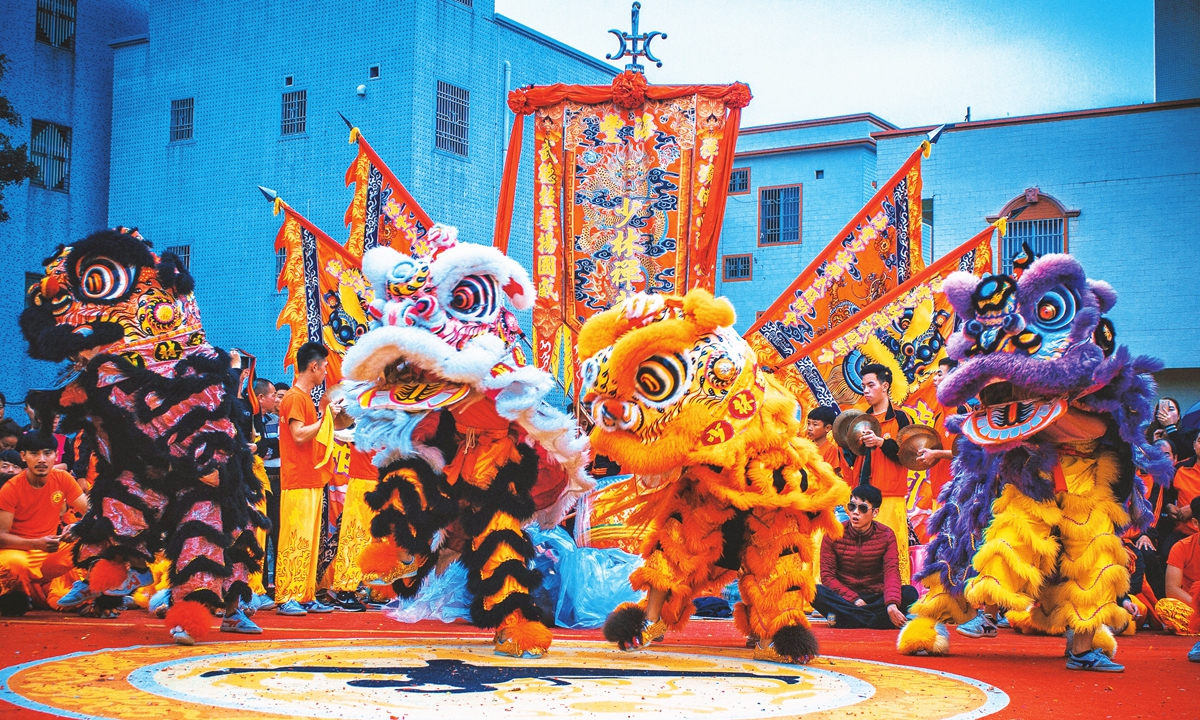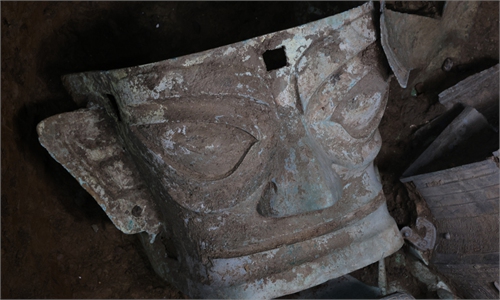ARTS / ART
Passion for culture boosts China’s food industry
A dash of tradition

A group of young people perform the lion dance to celebrate the Spring Festival. Photo: IC

A lion dance bun, an innovative dish created by chef Chen Xiaodong, who was inspired by the traditional Chinese lion dance from South China's Guangdong Province Photo: Courtesy of Chen Xiaodong
Though China's food service industry has been traumatized like many other industries due to the more than two-year-long pandemic, it is now reawakening and being given a boost by people's rising passion for the country's intangible cultural heritage, as well as their unshakable loyalty toward food itself.
With simple ingredients like dough and various vegetables for color and a bit of deep frying, young chef Chen Xiaodong serves up a bun shaped like a lion head for his waiting customers. This innovative dish swiftly swept Chinese social media for its uniqueness. Chen was inspired to make the dish by the traditional lion dance of South China's Guangdong Province, where he was born and raised. Counting the years he studied at a vocational school in Foshan, one of the most famous cities in China for delicious food, he has been working in the food service industry as a chef for seven years by now.
"It looks quite easy, but in fact it took me an entire day to finish when I firstly came up with the idea," Chen told the Global Times.
After taking part in countless international catering competitions, the 22-year-old's biggest dream is to bring traditional Chinese elements into his work, so naturally the lion dance, with its very characteristic Guangdong style, quickly came to mind.
Dancing through time
This traditional dance was first introduced to the south of China from the north more than 1,000 years ago and over time it has gradually formed its own style and characteristics. Among the many southern versions, the Guangdong lion dance is the most representative.
Chinese folklore expert Peng Weiwen explained that there are no official records on the exact origin of the lion dance.
"Historical records show that during the Qing Dynasty (1644-1911), the lion dance was popular enough to become an industry at the time taking into account the well-known 'lion dance king' Zha Zuo and his steady stream of business after he opened a business in Foshan," added the expert.
But before that, the lion dance already had a long history in China after it was first introduced as a part of Buddhist rituals.
"The first time the lion dance appeared in any historical records was in the 7th century," he added.
Later as a massive number of Chinese nationals overseas went into countries in Southeast Asia such as Singapore and Malaysia at the end of the 20th century, festival traditions such as the lion dance were also brought to local Chinese communities.
Chen's innovation is also acknowledged by Li Wanzhen, a well-known lion dance inheritor in Guangdong.
"Overseas Chinese have retained and inherited this folk activity. The influence of traditional food with such extensive cultural value will also be as far-reaching," she said.
Saving snacks
Some experts say that over the past decades the traditional Chinese food industry, especially the snack sector, has been on the decline.
The reasons vary. Serious homogenization of food on offer at scenic spots, over commoditization and varied food quality have all contributed to the decline to the point people feared regional food was on the verge of being erased.
One of the most typical examples is Wangfujing Snack Street in Beijing, now a very popular tourist location. After it was renovated in 2000, many residents said that the place lost its position as a place for advocating Beijing's local food, instead it brought problems such as health issues and traffic jams.
"Since the renovation, the food here has become more and more strange and exaggerated. You can find steamed crab, 'stinky' tofu and fried squid but no Beijing snacks at all," complained a Beijing resident surnamed Sui.
In order to turn things around, many people in the industry have begun associating various regional cuisines with traditional culture that people are interested in, such as Chen's combination of dumplings and the lion dance.
Added value
In recent years, China's intangible cultural heritage has been taking a more prominent position in the food service industry.
In the "Eighth Batch of Representative Items in the Provincial Intangible Cultural Heritage List" released at the end of May by the Guangdong provincial government, 30 percent of listed items belonged to the food category. There are more local dishes listed as part of the country's intangible cultural heritage than ever before. These dishes tend to follow certain geographical trends, for instance, most noodle dishes on the list come from northern China, in the Water Banquet originating from royal or noble families is more prevalent in central China, while dim sum dominates southern China.
"We have to admit that when the food and intangible cultural heritage are linked, it is no longer about the food itself, but also a matter of cultural inheritance and promotion. When diners see a certain dish, they can immediately think of where it came from and the stories behind it," noted Chen.

